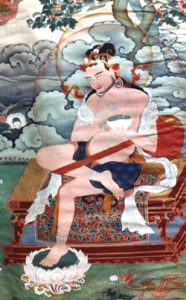Naropa — His Life and Teachings
Naropa (1016-1100) is one of the most prominent and authoritative Indian mahasiddhas and masters of mahahudra and tantra. He received the mahamudra and tantra lineage teachings from his guru Tilopa and transmitted them to his disciple, Marpa, the Great Translator of Tibet.
Naropa’s early life as a Brahmin
Naropa, known as Abhayakirti (‘jig med grags pa) Jnanasiddhi, was born in Kashmir into the Brahmin caste, according to Taranatha and other sources, who say that he was born in a place called Jambu (Shrinagar, according to Guenther) in eastern part of India. His father was Shantivarman and mother, Shrimati.
According to Taranatha, from an early age, he began to receive a complete education and became a tirthika pandit (scholar of non-buddhist teachings), also practicing the tantras of Hindusim. During this time, Naropa went to the house of a woman who sold beer and encountered a junior Buddhist pandita. After the Buddhist pandita departed, Naropa found a volume of Sutras left behind by him and began to read them. He became very inspired by the teachings and his heart filled with devotion for the dharma.
Naropa then went to Madhyadesha where he became an ordained monk in the Buddhist order, becoming educated in the Buddhist teachings. Naropa, who had been a tirthika pandita became instead the most learned pandita in the Buddha-dharma. He was honored for this accomplishment by being made the “Northern Gatekeeper” of Nalanda and Vikramashila universities. He taught at the universities and became one of the most well-known abbots of the time. During this time, he practiced the vajrayana tantric meditation of Cakrasamvara every evening and had many sacred visions of the dakinis. At some point, some dakinis encouraged him to leave by saying, “In the east is Tilopa. Go before him and you will attain great siddhi!”
Naropa searches for his teacher Tilopa
He traveled to the eastern regions and searched for Tilopa everywhere, but Tilopa was nowhere to be found. One day, Naropa was at a monastery in the eastern region. While in the monastery kitchen, a vile and filthy old man came in and roasted many live fish in the glowing fire. Naropa was unable to persuade him not to roast the fish alive, and the other monks jumped up and began to run towards the old man to stop him from killing. The old man responded: “If you don’t like it, just throw these roasted fish leftovers into the water!” Upon putting the roasted fish remains into water, they came to life and swam away in all directions.
Naropa then knew that the old man was a realized siddha. Following after him, he prostrated at his feet and begged him to teach. The old man became angry and struck Naropa without saying anything. When Naropa thought to himself, “Is this yogi Tilopa?” the old man answered: “Yes! Yes!” When Naropa thought “Is this yogi someone other than Tilopa?” the old man replied: “No! No!” At that point, he realized that this old man was Tilopa.
Tilopa sometimes manifested as a yogi by performing yogic deeds and sometimes just seemed to be a simple madman. During all these times Naropa had no conceptual thoughts or doubts about Tilopa’s realization.
Developing Naropa’s devotion
Once Naropa received a lot of vegetables from a wedding celebration and he offered them to Tilopa. Tilopa asked for more and so Naropa went again to the wedding reception, thinking that it would please his Guru. In India, it is not the accepted custom to go to a banquet twice in one day, so Naropa stole the whole pot of vegetables and carried it off. The people at the wedding caught him stealing and beat him with sticks and rocks, but Naropa managed to hang onto the pot and bring the vegetables to his guru.
At another time, Tilopa and Naropa encountered a princess sitting in a palyanka (palanquin) on the road. Tilopa said, “Grab the princess and bring her here!” Naropa transformed himself into a Brahmin and, uttering auspicious words, he put flowers on the girl’s head. He then grabbed her and fled with her; the servants of the princess however caught up with him, and beat Naropa to the ground until he was like a corpse. Naropa subsequently recovered through the blessings and skillful means of his guru.
Once again, Tilopa and Naropa met someone’s wife, this time married to a minister. Tilopa wanted her as his wife and told Naropa to do as he had done previously. Naropa paid her parents the price for a high caste girl and took her off with him. He thought he would offer her to his guru in the morning, but Naropa became very ill and was sick for many days. During this time, his guru recited mantras and Naropa soon recovered fully. At that time, Naropa offered the girl to Tilopa. However, the girl was so attacted to Naropa that she made love-glances at Naropa. Seeing this, Tilopa got very mad and said to the girl: “You don’t like me but instead, you like him.” He then beat both Naropa and the girl.
Those and many similar deeds were done in order to develop Naropa’s faith. During all of these events that Naropa went through, his devotion and faith remained firm and was not shaken even slightly. Not only did it not diminish; in fact his faith and devotion expanded. In this way, Naropa served his guru Tilopa for twelve years and although he went through numerous hardships, Tilopa never even spoke a single good word to him.
The famous sandal transmission from Tilopa
Finally, when they were at an empty plain Tilopa said, “Now make a mandala offering so I can give you the upadesha (key instructions).” Naropa looked around and said: “There are no flowers nor any water here to make mandala offering.” Tilopa answered: “Does your body not have blood and fingers?” so Naropa cut himself and sprinkled the ground with his own blood; he then cut off his fingers and arrayed them as if they were flowers. Tilopa then struck him with a muddy sandal and knocked him unconscious. When he woke up he was able to see the reality of things as they are. Naropa was completely healed and was given all the upadeshas and further instructions. Naropa became one of the greatest yogins and Tilopa instructed him: “Now, don’t debate, don’t teach any students – if you act thus you will swiftly attain the highest state.”
When Naropa was abiding at Phullahari monastery, he engaged in non-conceptual meditation. However, events forced him into a debate with a Tirthika, at which time Tilopa appeared and helped Naropa. Thus he did not fully comply with the instructions, which caused him some obstacles in the path.
Naropa stayed mostly in Phullahari, near Nalanda and also he wandered around various places conducting abhishekas, teaching tantras, giving upadeshas, and also engaging in great activities for the benefit of many sentient beings. Naropa attained the realization of the Reality and became one of the most renowned mahasiddas of India.
Naropa had many students including, Shantipa, Atisha, and many other masters who where door-keeper panditas. Among his students, there were eight extraordinary disciples, four who were learned in the Father Tantras and four who where learned in Mother Tantras and held the Oral Instructions lineage. Foremost among his disciples was the Tibetan Marpa, the great translator, who brought the lineage of Naropa to Tibet and continued it through his great disciple, Milarepa. The principal student and lineage heir of Naropa was Marpa.



